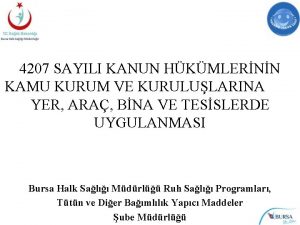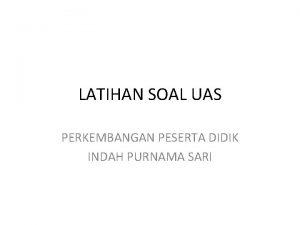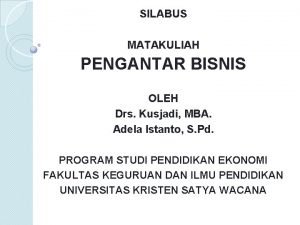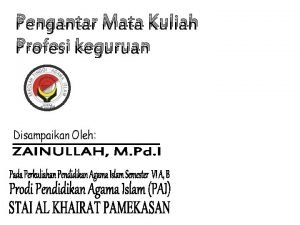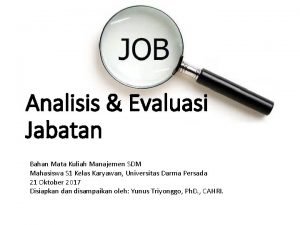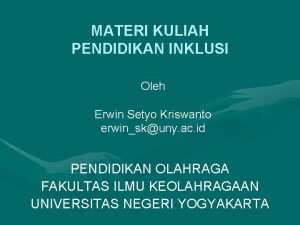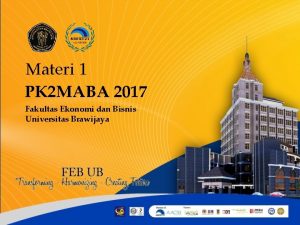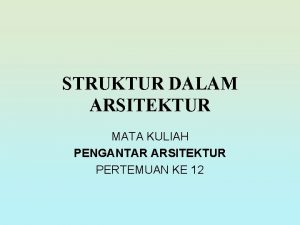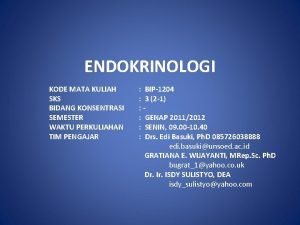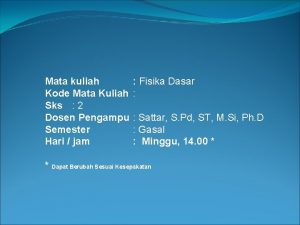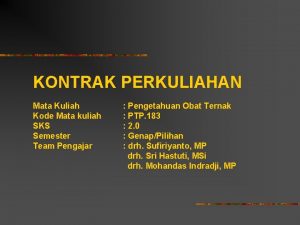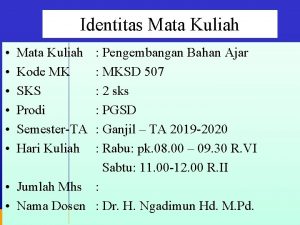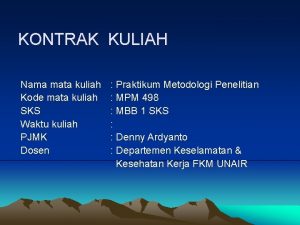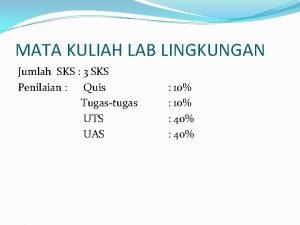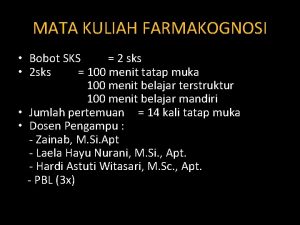ENDOKRINOLOGI PKH 4207 2 SKS DISKRIPSI MATA KULIAH

















- Slides: 17

ENDOKRINOLOGI PKH 4207 /2 SKS

DISKRIPSI MATA KULIAH Mata kuliah Endokrinologi akan membahas tentang konsep dasar sistem endokrin, jenis, fungsi, peran dan mekanisme hormon, substansi like hormon, ketidak seimbangan hormonal dalam sintesa protein, sistem pertumbuhan, urigenital, digesti, kardiovaskuler, respirasi, syaraf dan kekebalan. Sehingga pada akhir pembelajaran mahasiswa dapat memahami, mensintesakan dan menyajikan di depan kelas tentang mekanisme dan peran hormon pada performance hewan

Learning Objective l Memahami tujuan, manfaat, keterkaitan dg mk yang lain dalam mencapai kompetensi lulusan l Semaster ini MK yang berkaitan : Biokimia. Veteriner 2 , Fisiologi Veteriner

The systemic problem “Many compounds introduced into the environment by human activity are capable of disrupting the endocrine system of animals, including fish, wildlife, and humans. The consequences of such disruption can be profound. . . ” -.

Arnold A Berthold (1803 -1861) l In one of the first endocrine experiments ever recorded, Professor Arnold A. Berthold of Gottingen did a series of tests on roosters in 1849 while he was curator of the local zoo.

Claude Bernard (1813 -1878) Claude Bernard stated that the endocrine system regulates the internal milieu of an animal. The “internal secretions” were liberated by one part of the body, traveled via the bloodstream to distant targets cells. Circa 1854 Bernard's charge was to demonstrate that medicine, in order to progress, must be founded on experimental physiology.

Charles Edouard Brown-Séquard (1817 -1894) l l Brown-Sequard further piqued mainstream scientific interest in the chemical contents of the testes with his famous auto-experimentation. On June 1, 1889, before the Sociète de Biologic in Paris, Brown. Sequard reported that he had increased his physical strength, mental abilities and appetite by selfinjection with an extract derived from the testicles of dogs and guinea pigs Although never substantiated, this claim prompted researchers around the world to pursue the new field of organotherapy

Ernest Henry Starling (1866 -1927) l l Besides "his" law of the heart, Starling discovered the functional significance of serum proteins. In 1902 along with Bayliss he demonstrated that secretin stimulates pancreatic secretion. In 1924 along with E. B. Vernay he demonstrated the reabsorption of water by the tubules of the kidney. He was the first to use the term hormone

Animal evidence surrounds us l l Like many other mammals from the Lower Columbia River are infertile because the males’ penises are too small to mate Alligators affected by pesticides cannot reproduce Male fish develop female hormones In birds, eggshells thin so chicks cannot survive

Endocrine Glands Hypothalamus Pineal Adrenal Ovary Uterus Pituitary Testes (in bull) Thyroid Pancreas

The body has three marvelous communication systems l l l The nervous system The immune system The endocrine system, a network of glands which release hormones

Hormones are chemical signals which regulate almost every biological process: l Growth and development l Mental development, mood, memory l Sexual maturation l Immune function

Hormones are released by the glands l And travel through the blood until they reach their particular receptor cell l Where they fit, like a key in a lock, to turn on or off functions

Endocrine Disrupting Chemicals l l Are natural or man-made compounds Which fit into hormone receptors Blocking the normal hormone, or Acting instead of the normal hormone, in an irregular manner

Endocrine system maintains homeostasis The concept that hormones acting on distant target cells to maintain the stability of the internal milieu was a major advance in physiological understanding. The secretion of the hormone was evoked by a change in the milieu and the resulting action on the target cell restored the milieu to normal. The desired return to the status quo results in the maintenance of homeostasis

Early development is crucial A particular signal blocked during early pregnancy can affect both children and adults For example, children of mothers who ate low doses of PCBs in fish from Lake Michigan show effects 11 years later

Hormone Systems We Know Can Be Affected Endocrine system Functions Glucocorticoids Glucose, carbohydrate, lipid, protein metabolism Sexual development Estrogen Progesterone Thyroid Retinoids Menstruation cycle, synthesis of testosterone Brain development, behaviour Cell differentiation, Growth of limbs
 4207 sayılı kanun
4207 sayılı kanun Mata kuliah keamanan sistem informasi
Mata kuliah keamanan sistem informasi Mata kuliah geografi ui
Mata kuliah geografi ui Mata kuliah testing dan implementasi sistem
Mata kuliah testing dan implementasi sistem Mata kuliah administrasi perpajakan ui
Mata kuliah administrasi perpajakan ui Kurikulum informatika gunadarma
Kurikulum informatika gunadarma Mata kuliah advokasi
Mata kuliah advokasi Soal tentang perkembangan peserta didik
Soal tentang perkembangan peserta didik Mata kuliah keamanan sistem informasi
Mata kuliah keamanan sistem informasi Pengantar aplikasi komputer (spss)
Pengantar aplikasi komputer (spss) Deskripsi mata kuliah pengantar bisnis
Deskripsi mata kuliah pengantar bisnis Fakultas teknologi industri gunadarma
Fakultas teknologi industri gunadarma 3 pilar kunci guru profesional
3 pilar kunci guru profesional Mata kuliah analisis jabatan
Mata kuliah analisis jabatan Mata kuliah creative writing
Mata kuliah creative writing Mata kuliah pendidikan inklusi
Mata kuliah pendidikan inklusi Matkul ekonomi pembangunan ub
Matkul ekonomi pembangunan ub Mata kuliah pengantar arsitektur
Mata kuliah pengantar arsitektur
